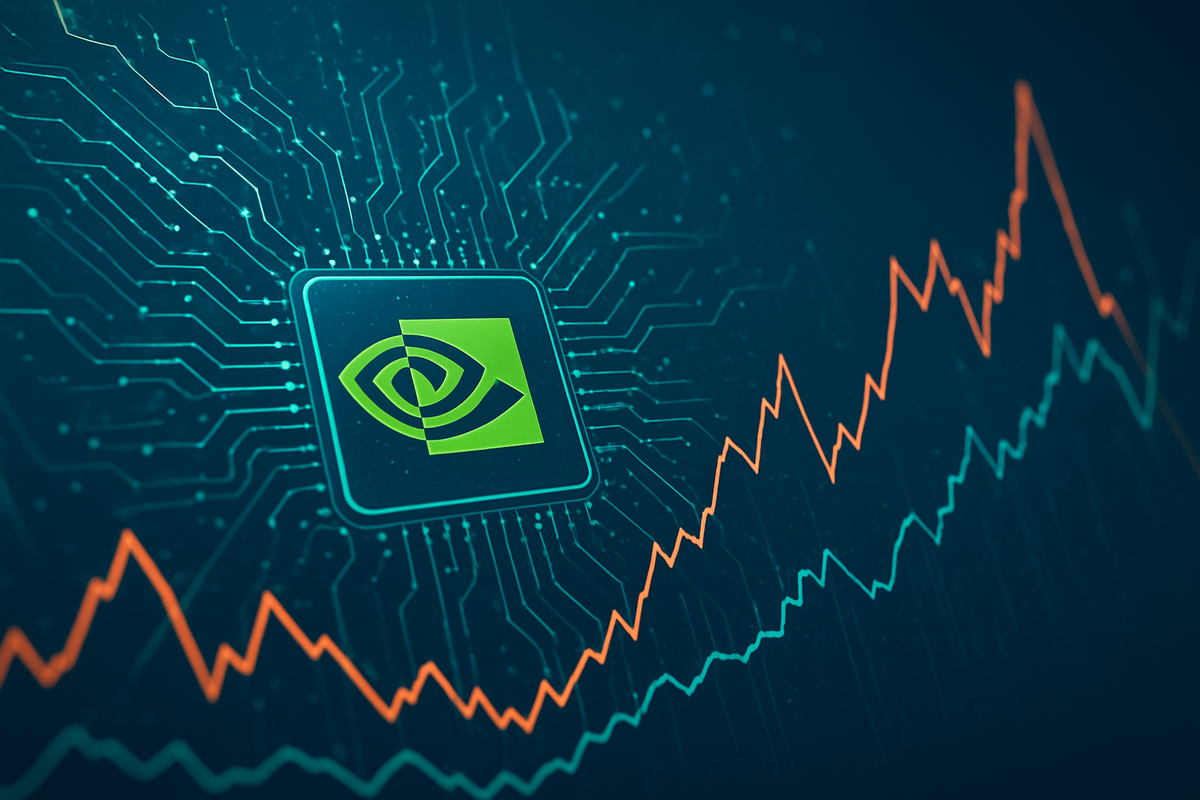
Nvidia (NASDAQ: NVDA), the undisputed titan of artificial intelligence chip manufacturing, has been at the epicenter of significant market movements and intense speculation following its recent stellar earnings report. Despite shattering analyst expectations with record revenues and an optimistic outlook, the company's stock has experienced notable swings, igniting fervent discussions across financial markets about the potential formation of an "AI bubble." This volatility, coupled with the extraordinary valuations seen across the AI sector, is not only influencing the performance of major technology firms but also contributing to a palpable sense of apprehension throughout the broader stock market. As Nvidia's market capitalization briefly touched an unprecedented $5 trillion, its every movement is scrutinized as a barometer for the entire AI-driven rally, prompting investors to weigh genuine technological transformation against the specter of speculative excess.
Nvidia's AI Dominance Meets Market Skepticism
Nvidia's financial performance has been nothing short of spectacular, yet it has paradoxically amplified concerns about market sustainability. The company's third-quarter fiscal year 2026 earnings report, released on November 19, 2025, showcased a dominant position in the burgeoning AI landscape. Nvidia reported a record revenue of $57.0 billion, marking a substantial 22% sequential increase and an astounding 62% year-over-year jump, comfortably surpassing Wall Street's forecasts. Adjusted earnings per share (EPS) also exceeded expectations at $1.30.
The primary engine behind this explosive growth was Nvidia's Data Center segment, which alone generated a record $51.2 billion in revenue, a 25% increase quarter-over-quarter and a 66% surge year-over-year. This segment now accounts for the vast majority of the company's total sales, underscoring the insatiable demand for its specialized AI chips that power large language models and other advanced AI applications. CEO Jensen Huang's declaration that "Blackwell sales are off the charts, and cloud GPUs are sold out" highlighted the immense, ongoing demand for their proprietary superchips. The company also provided an optimistic revenue forecast of $65.0 billion (plus or minus 2%) for the fourth quarter of fiscal year 2026, further cementing its leadership.
Despite these glowing figures, Nvidia's stock has demonstrated considerable volatility. For instance, on November 21, 2025, the stock decreased by 3.05%, following a 3.15% drop on November 20, 2025. This post-earnings dip, despite the positive report, underscores a market grappling with an "increasingly fragile tone" and deep-seated concerns about an AI bubble. The company's significant weighting in indices like the S&P 500 means that its sharp movements can single-handedly sway the direction of the broader market, making its earnings calls critical tests for the entire AI-fueled rally. This delicate balance between robust corporate performance and broader market jitters defines the current investment landscape for Nvidia and the AI sector.
The Winners and Losers in the AI Gold Rush
The significant swings in Nvidia's (NASDAQ: NVDA) stock and the broader "AI bubble" discourse are creating a discernible divide among public companies, distinguishing those poised to win from those facing potential headwinds. At the forefront of the beneficiaries are companies deeply integrated into the AI infrastructure ecosystem, particularly the "hyper-scalers" and cloud computing giants.
Potential Winners:
- Cloud Computing Providers: Companies like Microsoft (NASDAQ: MSFT) with Azure, Amazon (NASDAQ: AMZN) with AWS, and Alphabet (NASDAQ: GOOGL) with Google Cloud are direct beneficiaries of the AI boom. They are massive purchasers of Nvidia's GPUs and other AI hardware, which they then lease to customers for AI development and deployment. While their investments are substantial, the long-term demand for AI compute power ensures a steady revenue stream and strengthens their competitive moat in the cloud market. Their ability to monetize AI services, from model training to inference, positions them strongly.
- AI Software and Service Providers: Firms developing AI applications, platforms, and specialized services, such as Palantir Technologies (NYSE: PLTR) or various AI-focused startups, could thrive as the underlying infrastructure becomes more powerful and accessible. Their success is predicated on the widespread adoption and utility of AI, which Nvidia's hardware enables.
- Other Chip Manufacturers (Selectively): While Nvidia dominates GPUs, other chipmakers focusing on complementary AI hardware or specialized processors, such as Advanced Micro Devices (NASDAQ: AMD) in the server CPU and GPU space, or companies developing custom AI accelerators, might also find niches. However, their success is often measured against Nvidia's formidable lead.
Potential Losers/At Risk:
- Companies with Overinflated AI Valuations: Many smaller, pure-play AI companies with high valuations but unproven business models or limited profitability could be vulnerable if the "AI bubble" were to burst or deflate. Investors might become more discerning, shifting capital away from speculative ventures towards established players with tangible revenues.
- Traditional Software Companies Slow to Adapt: Legacy software companies that fail to integrate AI effectively into their products or develop new AI-powered offerings could see their competitive edge erode. The rapid pace of AI innovation demands constant adaptation, and those lagging could lose market share.
- Companies Heavily Reliant on Single AI Applications: Businesses that have invested heavily in a narrow AI application without diversification could face risks if that specific application's market demand wanes or if superior alternatives emerge.
- Consumer Electronics (Non-AI focused): While some consumer electronics benefit from AI integration, sectors less directly tied to the core AI infrastructure or advanced AI applications might see capital diverted away from them towards the perceived higher growth of the AI sector.
The market's current climate suggests a flight to quality within the AI space. Companies with strong balance sheets, diversified revenue streams, and clear pathways to monetizing AI are likely to weather potential turbulence better than those built on speculative hype alone.
The Broader Implications of the AI Gold Rush
Nvidia's (NASDAQ: NVDA) stock volatility and the "AI bubble" discussions are not isolated events; they are symptoms of a profound technological shift with far-reaching implications for the global economy and financial markets. This situation fits into a broader industry trend of rapid technological adoption, reminiscent of past industrial revolutions, but with an unprecedented pace driven by digital connectivity and computational power.
Broader Industry Trends and Ripple Effects:
- Accelerated Digital Transformation: The AI boom is compelling nearly every industry, from healthcare to manufacturing, to accelerate their digital transformation initiatives. Companies are scrambling to integrate AI into their operations, products, and services to remain competitive, creating ripple effects for consulting firms, data providers, and cybersecurity companies.
- Increased R&D Spending: The race for AI dominance is driving unprecedented levels of research and development spending across the tech sector and beyond. This fuels innovation but also raises questions about the long-term return on investment for some of these ventures.
- Talent Scarcity and Wage Inflation: The demand for AI engineers, data scientists, and machine learning specialists has surged, leading to intense competition for talent and significant wage inflation in these specialized fields, impacting recruitment strategies across industries.
- Supply Chain Pressures: The immense demand for advanced AI chips and related hardware is putting pressure on global supply chains, affecting manufacturers of semiconductors, specialized cooling systems, and data center components.
- Energy Consumption Concerns: The computational intensity of AI models, particularly large language models, is leading to a significant increase in energy consumption by data centers, raising environmental concerns and prompting innovation in energy-efficient computing and sustainable data center design.
Regulatory and Policy Implications:
- Antitrust Scrutiny: The increasing concentration of power among a few dominant AI hardware and software providers, like Nvidia, could attract greater antitrust scrutiny from regulators globally, aiming to prevent monopolies and foster competition.
- AI Ethics and Governance: Governments worldwide are grappling with the ethical implications of AI, including issues of bias, privacy, intellectual property, and autonomous decision-making. This will likely lead to the development of new regulatory frameworks and standards for AI development and deployment, which could impact how companies operate and innovate.
- National Security and Geopolitics: AI is recognized as a critical technology for national security. This has led to export controls on advanced AI chips and equipment, particularly impacting relations between the US and China, and creating a complex geopolitical landscape for technology companies.
Historical Precedents:
Comparisons to the dot-com bubble of the late 1990s are inevitable. During that era, companies with "dot-com" in their name saw their valuations skyrocket based on speculative promise rather than proven profitability. While the current AI boom shares some characteristics – rapid valuation surges, intense investor enthusiasm, and a focus on transformative technology – there are key differences. Unlike many dot-com companies, Nvidia and other leading AI firms possess strong fundamentals, significant revenues, and clear business models. However, the risk lies in the broader market's willingness to overpay for future potential, which can lead to corrections when expectations outpace reality. The "Nifty Fifty" era of the 1960s and early 70s, where a group of blue-chip stocks traded at elevated multiples, also serves as a cautionary tale about market concentration and overvaluation, even for fundamentally strong companies.
Navigating the Future of AI Investment
The current landscape, marked by Nvidia's (NASDAQ: NVDA) volatility and the "AI bubble" debate, points to a dynamic and potentially transformative period ahead for financial markets and the technology sector. Understanding what comes next requires considering both short-term market reactions and long-term strategic shifts.
Short-Term and Long-Term Possibilities:
In the short term, we can expect continued market volatility, particularly around key earnings reports from major AI players and macroeconomic data releases. Investor sentiment will remain highly sensitive to any news that either confirms the AI growth narrative or suggests overextension. There might be periodic profit-taking corrections as some investors lock in gains, especially if the broader market shows signs of weakness. For Nvidia specifically, while demand remains robust, any signs of cooling in hyperscaler spending or increased competition could trigger immediate stock reactions.
In the long term, the fundamental drivers of AI adoption—such as increased automation, data analysis capabilities, and the creation of new products and services—are likely to persist. This suggests that the underlying growth trajectory for AI technology and its foundational companies remains strong. However, the market will likely mature, differentiating between companies with sustainable business models and those built on speculative hype. We could see a consolidation in the AI sector, with larger, well-capitalized companies acquiring innovative startups.
Potential Strategic Pivots or Adaptations Required:
- Diversification for Tech Giants: Major tech firms heavily invested in AI will need to diversify their AI strategies beyond just hardware procurement. This includes investing in AI software development, ethical AI frameworks, and applications across various industries to create more resilient revenue streams.
- Focus on Profitability for Startups: AI startups, particularly those with high burn rates, will face increasing pressure to demonstrate clear paths to profitability rather than solely focusing on user growth or technological breakthroughs. Access to capital might become more selective.
- Vertical Integration: Some companies might pursue greater vertical integration, developing their own custom AI chips or software to reduce reliance on external suppliers and optimize performance, though this is a capital-intensive strategy.
- Ethical AI Development: As regulatory scrutiny increases, all players will need to prioritize ethical AI development, ensuring transparency, fairness, and accountability in their algorithms and applications.
Market Opportunities and Challenges:
Opportunities:
- Specialized AI Solutions: The demand for AI solutions tailored to specific industries (e.g., AI in healthcare, finance, or logistics) will create significant opportunities for niche players.
- AI Infrastructure Beyond Chips: Opportunities exist in related infrastructure, such as advanced cooling systems, energy-efficient data centers, and specialized networking hardware, which are essential for scaling AI.
- AI Security and Governance: As AI becomes more pervasive, the need for robust AI security, compliance, and governance solutions will grow exponentially.
Challenges:
- Intensifying Competition: The lucrative nature of the AI market will continue to attract new entrants, leading to intensifying competition and potential price compression for certain products and services.
- Regulatory Uncertainty: Evolving AI regulations could create compliance challenges and potentially slow down innovation in certain areas.
- Talent Wars: The ongoing struggle to attract and retain top AI talent will remain a significant hurdle for many companies.
- Economic Headwinds: A broader economic slowdown could temper corporate spending on AI initiatives, impacting growth projections.
Potential Scenarios and Outcomes:
- Soft Landing: The most optimistic scenario sees the AI sector continuing its strong growth, but with a gradual re-evaluation of valuations, leading to a "soft landing" rather than a burst bubble. Companies with strong fundamentals continue to thrive, while weaker players are weeded out.
- Correction and Consolidation: A more cautious scenario involves a significant market correction in AI-related stocks, followed by a period of consolidation where established players acquire or absorb struggling startups.
- Continued Hypergrowth (Less Likely without Correction): While possible, sustained hypergrowth without any significant correction becomes less probable as market skepticism grows and valuations stretch.
Ultimately, the future will likely involve a blend of these scenarios, with the enduring power of AI technology continuing to drive innovation, but within a more scrutinized and potentially volatile market environment.
Concluding Thoughts on the AI Revolution
Nvidia's (NASDAQ: NVDA) recent stock performance and the surrounding "AI bubble" discourse encapsulate the exhilarating yet precarious nature of the current technological revolution. The company's record-breaking earnings underscore the profound and accelerating demand for artificial intelligence infrastructure, confirming that AI is not merely a fleeting trend but a fundamental shift reshaping industries globally. However, the market's nervous reaction to these stellar results, manifested in significant stock volatility, highlights a growing apprehension that valuations in the AI sector may be outpacing tangible, immediate returns, drawing parallels to historical speculative manias.
Moving forward, the market will likely demand greater scrutiny and discernment from investors. The era of broad, indiscriminate investment in anything labeled "AI" may be drawing to a close. Instead, a focus on companies with clear business models, sustainable profitability, and a demonstrable competitive advantage within the AI ecosystem will become paramount. This includes not only the chipmakers like Nvidia but also the cloud providers, specialized AI software developers, and enterprises effectively integrating AI to drive efficiency and innovation.
Investors should closely monitor several key indicators in the coming months. These include the spending patterns of major hyperscalers on AI infrastructure, which directly impacts Nvidia's core business; the emergence of new regulatory frameworks for AI, which could shape industry practices; and the actual return on investment from corporate AI initiatives, which will validate or challenge current valuations. Furthermore, any significant shifts in the competitive landscape, such as new entrants or technological breakthroughs from rivals, will be critical to watch. While the potential for AI to transform the global economy remains immense, the path ahead will likely be characterized by both continued innovation and heightened market scrutiny, requiring a balanced perspective from all stakeholders.
This content is intended for informational purposes only and is not financial advice





